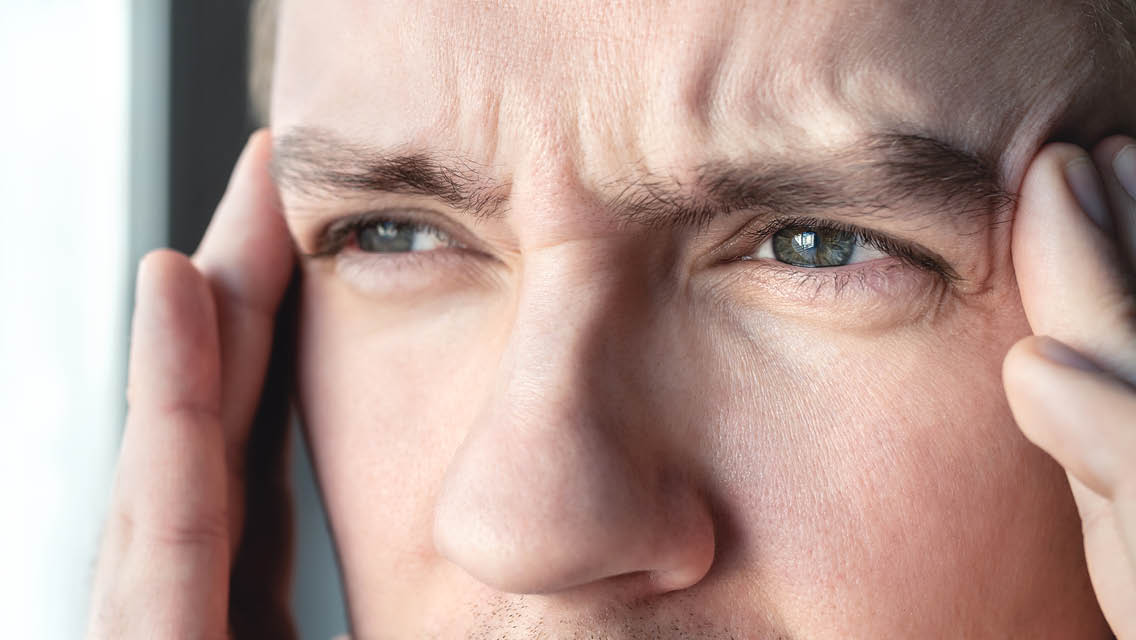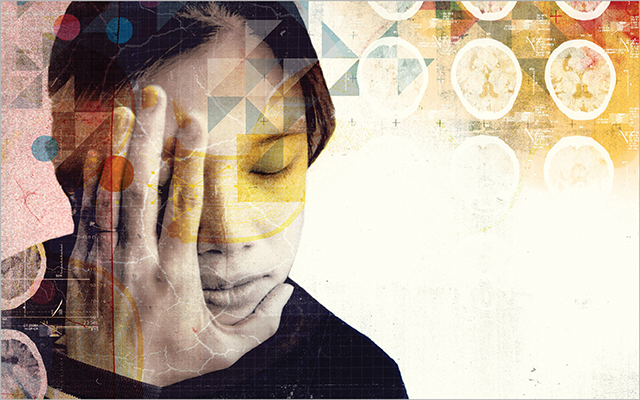Have you ever hit your head so hard you felt foggy, jittery, anxious, dizzy, easily startled? These are among the symptoms of a concussion and more severe levels of traumatic brain injury (TBI).
Most of the estimated 1.5 million Americans who sustain a head injury each year recover in about a month as neuroinflammation recedes, according to the Centers for Disease Control and Prevention. But for about 10 to 20 percent of people who’ve had a head injury, such symptoms (known broadly as postconcussion syndrome, or PCS) linger for months, years, or sometimes the rest of their lives.
Healthcare experts now understand that a brain injury can tweak the brainstem, an area that oversees our primitive reflexes — reflexes critical for our development and survival in early life. These include the mechanics involved in rolling over and crawling, eye-hand coordination, balance, head movement, and the Moro, or startle, reflex, which is an early version of the fight-or-flight response.
“As your brain develops and your frontal lobe starts to kick in, these reflexes are basically in the background, but they’re still there — and they reemerge with brain trauma,” explains Jeremy Schmoe, DC, DACNB, founder and director of the Functional Neurology Center in Minnetonka, Minn. “It’s common for patients post-TBI to develop issues with gait, balance, autonomic dysfunction, eye-tracking difficulties, cognitive dysfunction, dizziness, vertigo, startle reflexes, and sensory overstimulation.”
“You can still make improvements to the brain after having a concussion 10 years ago. Your brain’s very plastic in the way that it can adapt.”
In addition, those with PCS may have “sudden difficulty with reading, handwriting, cross-body movements, balance and coordination, and behaviors such as increased fidgeting or difficulty sitting still and concentrating,” says Lauren Ziaks, PT, DPT, cofounder of Phoenix Concussion Recovery in Park City, Utah.
In the past, concussion recovery focused on rest and time. “The traditional management of concussion mandated complete physical and cognitive rest,” explains William Mullally, MD, in a 2017 report in the American Journal of Medicine.
But a new understanding of the brain’s neuroplasticity — the ability of the brain to grow, adapt, and change throughout our lives — has led to new therapies to treat PCS.
- Cognitive rehabilitation therapy (CRT) focuses on memory games and other brain exercises to rebuild memory functions and rehabilitate attention span. CRT can also help patients cope with persistent issues involving problem-solving, speech and communication, reading and writing, spatial perception, and executive-function skills.
- Physical rehabilitation therapy uses exercises to restore balance, gait, and other motor skills. Therapists also use gaming and virtual-reality tools as an adjunct to physical therapy.
- Functional-neurology therapy integrates strategies to help re-coordinate your primitive reflexes. It begins with a wide-ranging neurological exam of reflexes, including your balance, posture, gait, eye movement, pupillary response, hand grasp, rooting reflex, and more. Based on your response, the therapist creates an individualized regimen.
“We’ve found that we can speed the recovery process up if we get more specific with working on right-brain, left-brain and not being so generalized,” Schmoe says. Therapies can rehabilitate eye–hand coordination as well as the vestibular system and sense of balance. Patients lie on a tilt table or sit in a GyroStim multiaxis rotating chair to calm their autonomic nervous system and startle response.
Schmoe also uses low-level laser therapy to improve blood flow and reduce brain inflammation, plus hyperbaric oxygen to improve oxygenation in the brain. Such techniques, he says, help “stimulate the brain, to bring the frontal lobe back online and get people thinking quicker.”
Functional neurology can begin soon after a brain injury — or even years later, he explains. “You can still make improvements to the brain after having a concussion 10 years ago. Your brain’s very plastic in the way that it can adapt.”
WEBEXTRA
Healing From a Head Injury: A Q&A With Dr. Jeremy Schmoe
Functional neurology integrates therapies to help recoordinate our primitive reflexes after a concussion or traumatic brain injury. Learn more about how the treatment works.
After a concussion or more severe traumatic brain injury (TBI), it’s common for people to feel a wide range of confusing symptoms, including fogginess, dizziness, anxiety, and jitteriness. That’s because the injury can jostle the brain, reawakening our primitive reflexes from when we were born. These include the coordination for rolling over and crawling, eye–hand coordination, balance, head movement, and the Moro (or startle) reflex, which governs an early fight-or-flight response.
Functional neurology seeks to resynchronize these primitive reflexes and restore our overall sense of balance.
We spoke with Jeremy Schmoe, DC, DACNB, founder and director of the Functional Neurology Center in Minnetonka, Minn., about how functional-neurology therapy works.
Experience Life | Can you explain what our primitive reflexes are — and how a head injury might reignite them?
Jeremy Schmoe | Basically, in the womb, your brain develops in stages with the vestibular system, then your somatic sensory system, then smell, then your auditory system, and then vision. And then it develops these coding, these movement patterns, which are primitive in nature, to allow you to be able to get out of the womb and be born and help you with survival strategies. Then, when you’re a baby, and as you start to move and crawl and roll over, those reflexes are hardwired. As your brain develops and your frontal lobe starts to kick in, these reflexes are basically inhibited — but they’re still there. And what happens is, they reemerge with brain trauma. You’ll see these primitive reflexes kick in with adverse childhood events, emotional trauma, concussion and TBI, dementia, post-inflammatory, post-infectious disorders. I’ve seen it in patients post-COVID and in patients with Lyme disease.
So as the brain goes down and as your frontal lobe isn’t integrating the way that it needs to, then you don’t inhibit these reflexes. These primitive things like a startle reflex come out, and it makes it really hard to go through your everyday world with things in your visual field startling you. Or you see something that you’re not supposed to see, because your eyes are moving around, for example. Loud noises can startle you, movement can startle you, touch or vibration can startle you.
EL | So functional-neurology therapy works through those primitive reflexes to recoordinate them — it’s, in a way, like being born again?
JS | Yes. It all starts with a detailed exam looking at all of your sensory systems. We want to watch you walk, look at your balance — with your eyes open and closed, on flat versus foam surfaces. And we have technologies where we get data and graph all your balance scores out. And then we graph out all your eye movements: We can look at your eyes in the dark, see if they’re drifting or moving. We pull you out of the dark, and see if your eyes are smooth, see if they can move quick, see if you can tolerate motion.
Then we look at other reflexive systems like your pupillary responses. They’re very primitive systems that allow you to be able to take in light appropriately and things like that. And they’re involved with your whole cortisol system, circadian rhythm, sleep, wake cycles — stuff like that, which can get off after head injuries.
We’ll look at the Moro reflex, which is the startle reflex. We’ll look at the palmar grasp reflex by stroking on the hand. We look at the rooting reflex, where we stroke on the side of the face and we’ll see if you get like an elevation of your cheek on that side, similar to a baby that turns his or her head and opens his or her mouth to nurse. It’s a primitive reflex for nursing.
When your brain becomes more primitive, you really fire your whole sympathetic stress system: You’re in a constant state of survival mode, and your body will do a whole bunch of different strategies to protect you. Your pupils might get bigger. You might be sweating more. You might change blood flow to your stomach. People can have gut issues when you’re in this chronic, sympathetic primitive state.
And then we also try to figure out, well, what other circuits of your brain aren’t functioning correctly? Is this more of an issue with your frontal lobe or your cerebellum? Or various regions in the brainstem? Is it more upper, middle, or lower brainstem? And we develop treatment strategies to get specific with how we’re going to activate your brain with using sensory stimulation.
So, we will do complex movements of the body. We’ll do different head and eye exercises. We will do aromatherapy, we’ll use olfaction. We’ll use different types of light stimulus to stimulate the brain. We could use vibration. We basically use all your sensory systems to activate networks in the brain to get them to function better.
Some of the other therapies that we do is low-level laser therapy, which can help with getting better blood flow and decreased brain inflammation. We also do hyperbaric oxygen to try and get just better oxygenation into the brain.
We’ve found that we can speed the recovery process up if we get more specific with working on right-brain, left-brain, or left-cerebellum, right-cerebellum, and not being so generalized. So, we try to get very specific with our examination and do other techniques to stimulate the brain, to bring the frontal lobe back online, get people thinking quicker.
One of the most important things that I see is working with the vestibular system. The vestibular system is the first system that develops in utero, and it commonly gets affected after head injuries. So, people feel dizzy and off balance — spin-y and floaty and rocky and rolly. We’ve found that if we do different types of vestibular techniques — combining that with the primitive-reflex exercises and then other strategies to work your autonomic nervous system, like vagus-nerve stimulation techniques — we can really get your system to integrate faster. In functional neurology, we try to make it more targeted for each individual person.
EL | How long does the rehabilitation process typically take?
JS | What we’ve seen is doing the therapy more intensely works the best. Many of the patients that we see with postconcussion syndrome, we actually see them starting with doing a five-day intensive program for 15 hours in one week. We do various types of therapies during that week to try and make improvements in all the objective findings that we saw during their examination.
We also see people that aren’t getting better doing other techniques. A lot of the people we see have lingering postconcussion symptoms; they’ve done physical therapy, they’ve seen MDs, they’ve done chiropractic care, they’ve done muscle work, they’ve done cognitive exercises. On average, I usually see them about three months after their injury, if they’re not getting better.
You can still make changes and improvements to the brain after having a concussion 10 years ago. Your brain’s very plastic in the way that it can adapt.
This article originally appeared as “The New Science of TBI Recovery” in the July/August 2022 issue of Experience Life.





This Post Has One Comment
Fascinating information that will help TBI patients to understand the underlying problems.